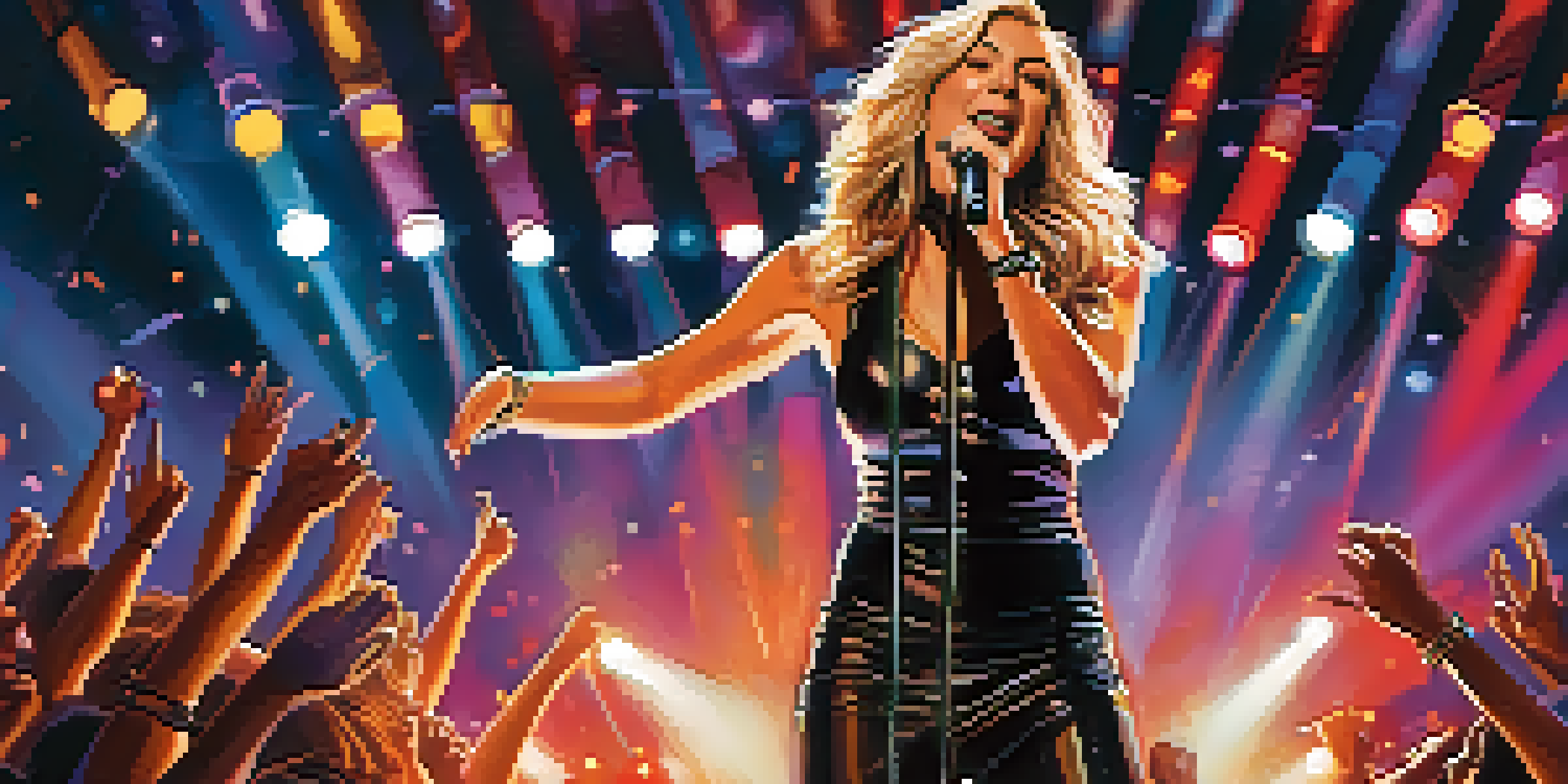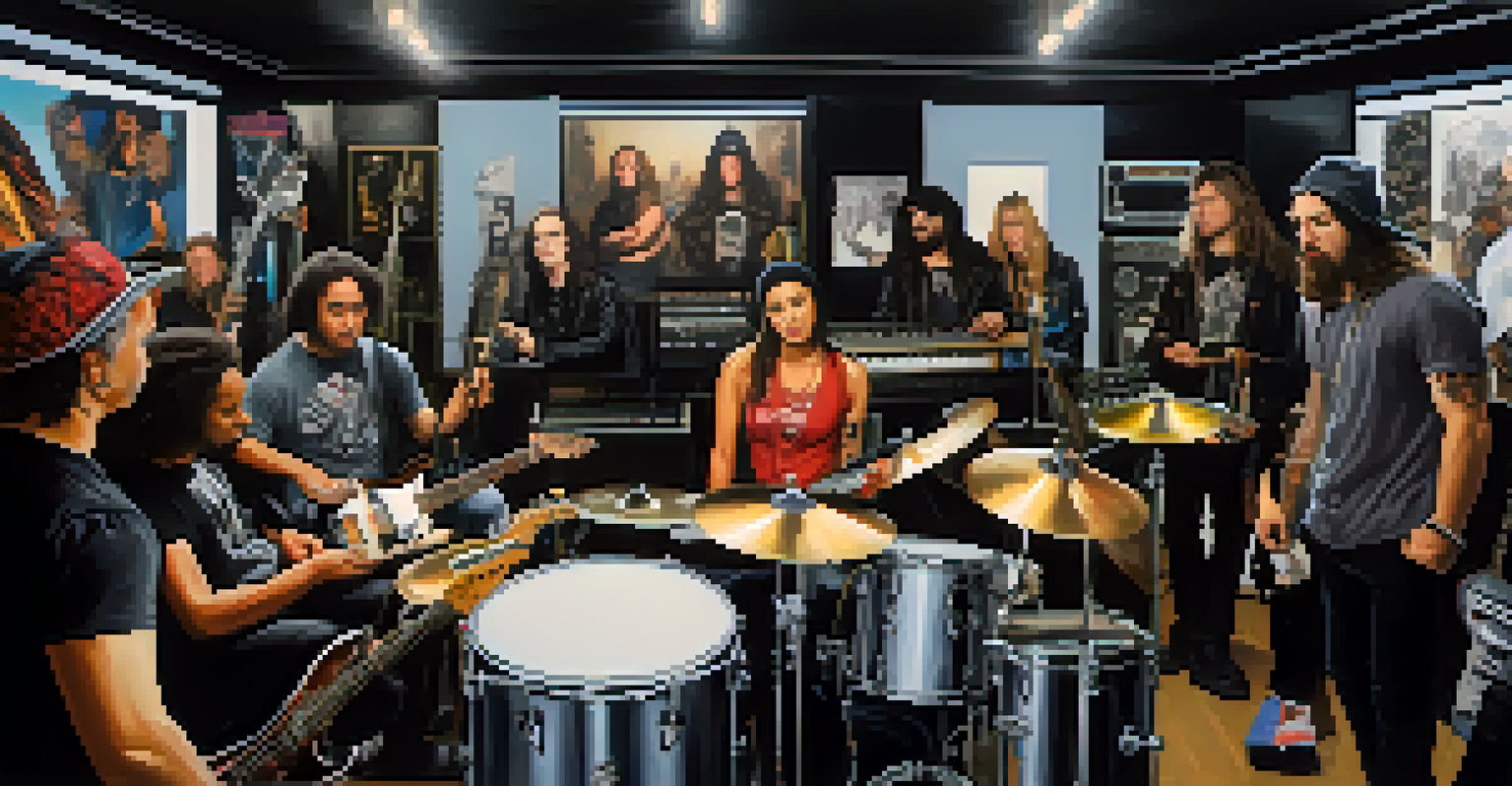Challenging Gender Roles in Heavy Metal Music Culture

Understanding Gender Dynamics in Heavy Metal
Heavy metal music has long been seen as a male-dominated space, often characterized by loud guitars, aggressive vocals, and a rebellious spirit. Historically, this genre has perpetuated traditional gender roles, with men typically taking center stage as performers and fans. However, as society evolves, so does the landscape of heavy metal culture, leading to a re-examination of these long-standing norms.
Music is a universal language that transcends boundaries and speaks to the individual soul, regardless of gender.
The roots of heavy metal can be traced back to the late 1960s and early 1970s, with bands like Black Sabbath and Led Zeppelin. These iconic groups not only shaped the sound of the genre but also established a culture that often sidelined female musicians. Yet, as more women began to carve out their space in the genre, it became clear that heavy metal could be a platform for challenging these outdated gender roles.
Today, we see a growing number of female artists and fans who are reshaping the narrative around gender in heavy metal. From powerful vocalists like Arch Enemy's Alissa White-Gluz to trailblazers like Lita Ford, women are proving that they can dominate in a space traditionally reserved for men. This shift invites us to consider how these changes impact the genre and its audience.
The Rise of Female Artists in Metal
In recent years, the heavy metal scene has experienced a surge of talented female musicians who are breaking through the barriers. Bands like Nightwish and Within Temptation have not only gained international acclaim but have also redefined expectations of women in the metal genre. Their success demonstrates that gender should not dictate one’s ability to rock out on stage.

Moreover, female-fronted bands are increasingly shifting narratives around femininity in heavy metal. They often confront stereotypes by embracing their identities while simultaneously showcasing their musical prowess. This empowers a new generation of female fans and musicians who see themselves represented in a genre that was once largely inaccessible.
Empowerment of Female Musicians
The rise of female artists in heavy metal is reshaping the genre, showcasing women's talent and challenging traditional gender roles.
The visibility of these artists encourages discussions about the importance of diversity within metal culture. As more women take on roles as musicians, producers, and fans, the genre becomes richer and more inclusive, paving the way for future talent to flourish, regardless of gender.
Challenging Stereotypes in Metal Culture
Heavy metal has long been associated with certain stereotypes, often depicting women in a hyper-sexualized manner. This portrayal can alienate female fans and musicians who seek to be recognized for their talent rather than their appearance. As the genre evolves, there’s a growing movement to challenge these stereotypes and foster a more respectful environment for all.
We need to create a world where everyone feels free to express themselves without fear of judgment.
Numerous artists are using their platforms to address issues such as sexism, body image, and mental health within the heavy metal community. For example, bands like Jinjer and Spiritbox tackle these subjects head-on in their lyrics and public statements, pushing back against harmful narratives. By doing so, they’re not just changing perceptions within metal but also promoting a broader cultural dialogue about gender equality.
This shift in perspective is crucial for the future of heavy metal. As more artists advocate for change, the community can begin to dismantle the stereotypes that have long defined it, allowing for a more inclusive and supportive space for all musicians and fans alike.
The Role of Male Allies in Heavy Metal
While female artists are leading the charge in challenging gender roles, the role of male allies in heavy metal culture cannot be overlooked. Male musicians and fans who actively support their female counterparts help to create an environment where diversity is valued and respected. This partnership can significantly influence the dynamics within the genre.
Artists like Dave Grohl and Corey Taylor have publicly championed the contributions of women in heavy metal, showcasing their talent and advocating for equal representation. By using their influence, they help to amplify the voices of female musicians who might otherwise go unheard. This solidarity is essential for dismantling the patriarchal structures that have long persisted in the music scene.
Challenging Stereotypes in Metal
A growing movement within heavy metal is addressing and dismantling harmful stereotypes, promoting a more respectful environment for all.
Moreover, male allies can help foster a culture of respect among fans as well. When male fans actively support female artists and challenge misogynistic behavior in the audience, they contribute to a safer and more inclusive environment for everyone. This collective effort can create a lasting impact on the heavy metal community.
The Impact of Social Media on Gender Roles
Social media has transformed the way artists engage with their fans, providing a platform for discussions around gender roles in heavy metal. Musicians can now share their experiences, connect with fans directly, and challenge stereotypes in real-time. This accessibility has empowered many to speak out about their struggles and triumphs within the genre.
Platforms like Instagram and Twitter have allowed female metal artists to build their personal brands and cultivate supportive communities. By sharing their journeys, they inspire others to break free from traditional roles and embrace their individuality. This newfound visibility helps to normalize the idea that anyone can be a heavy metal musician, regardless of gender.
Additionally, social media serves as a tool for activism, enabling artists and fans to organize and participate in movements that advocate for gender equality. This digital landscape has the potential to further dismantle outdated norms, making way for a more equitable future in heavy metal music.
Exploring Gender Identity Beyond Binary Roles
As conversations around gender evolve, heavy metal is beginning to embrace a more inclusive understanding of gender identity. Beyond the traditional male and female roles, there is a recognition of non-binary and genderqueer individuals within the metal community. This expansion of identity encourages a richer diversity of expression in the genre.
Artists such as Lilith Czar and Zeal & Ardor challenge conventional gender norms by embodying fluidity in their music and performances. Their work not only showcases their artistry but also invites fans to explore their own identities without restriction. This progressive approach creates a more welcoming environment for those who may have felt marginalized in the past.
Inclusivity Beyond Gender Binaries
Heavy metal is increasingly embracing diverse gender identities, fostering a richer culture of acceptance and expression within the community.
The inclusion of diverse gender identities in heavy metal enriches the genre and promotes a culture of acceptance. As more artists and fans share their stories, the community can continue to evolve, ensuring that everyone feels seen and heard in this vibrant musical space.
Looking Ahead: The Future of Gender in Metal
The future of heavy metal is poised for exciting changes as the conversation around gender roles continues to evolve. With more women and non-binary artists stepping into the spotlight, the genre is likely to embrace a wider range of perspectives and experiences. This shift not only enhances the music itself but also fosters a deeper sense of community among fans.
Education and awareness are key components in driving this change forward. Initiatives that celebrate diversity and promote inclusivity within heavy metal can help dismantle the barriers that have historically limited participation. As metalheads, it’s important to champion these efforts and support artists who are paving the way for future generations.

Ultimately, the challenge of redefining gender roles in heavy metal is an ongoing journey. By continuing to support diverse voices and engage in meaningful conversations, the heavy metal community can create an environment where everyone can thrive, regardless of their gender identity.